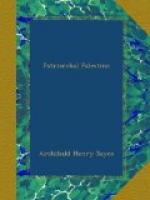Not so long ago it was the fashion to declare that such coincidences between Babylonian and Hebrew literature could be due only to the long sojourn of the Jews in Babylonia during the twenty years of the Exile. But we now know that the traditions and legends of Babylonia were already known in Canaan before the Israelites had entered the Promised Land. It was not needful for the Hebrew writer to go to Chaldaea in order that he might learn them; when Moses was born they were already current both in Palestine and on the banks of the Nile. The Babylonian colouring of the early chapters of Genesis is just what archaeology would teach us to expect it would have been, had the Pentateuch been of the age to which it lays claim.
Here and there indeed there are passages which must be of that age, and of none other. When in the tenth chapter of Genesis Canaan is made the brother of Cush and Mizraim, of Ethiopia and Egypt, we are carried back at once to the days when Palestine was an Egyptian province. The statement is applicable to no other age. Geographically Canaan lay outside the southern zone to which Egypt and Ethiopia belonged, except during the epoch of the eighteenth and nineteenth dynasties, when all three were alike portions of a single empire. With the fall of that empire the statement ceased to be correct or even conceivable. After the era of the Israelitish conquest Canaan and Egypt were separated one from the other, not to be again united save for a brief space towards the close of the Jewish monarchy. Palestine henceforth belonged to Asia, not to Africa, to the middle zone, that is to say, which was given over to the sons of Shem.
There is yet another passage in the same chapter of Genesis which takes us back to the Patriarchal Age of Palestine. It is the reference to Nimrod, the son of Cush, the beginning of whose kingdom was Babel and Erech, and Accad and Calneh in the land of Shinar, and who was so familiar a figure in the West that a proverb was current there concerning his prowess in the chase. Here again we are carried to a date when the Kassite kings of Babylonia held rule in Canaan, or led thither their armies, and when the Babylonians were called, as they are in the Tel el-Amarna tablets, the Kassi or sons of Cush. Nimrod himself may be the Kassite monarch Nazi-Murudas. The cuneiform texts of the period show that the names borne by the Kassite kings were strangely abbreviated by their subjects; even in Babylonia, Kasbe and Sagarta-Suria, for instance, being written for Kasbeias and Sagarakti-Suryas, the latter of which even appears as Sakti-Surias, while Nazi-Murudas itself is found under the form of Nazi-Rattas. Similarly Duri-galzu and Kurigalzu take the place of Dur-Kurigalzi. There is no reason, therefore, why Nazi-Murudas should not have been familiarly known as Na-Muruda, more especially in distant Canaan.




